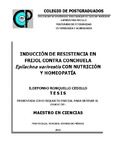Inducción de resistencia en frijol contra conchuela Epilachna varivestis con nutrición y homeopatía
Date
2015Author
Ronquillo Cedillo, Ildefonso
RONQUILLO CEDILLO, ILDEFONSO
Metadata
Show full item recordAbstract
El control de insectos plaga con insecticidas organosintéticos provoca varios problemas, por ello se han implementado varias alternativas; sin embargo, éstas no se han integrado para lograr un mejor manejo, por esto se realizó esta investigación para evaluar el efecto de la fertilización mineral u orgánica y sin fertilizar, suelo convencional u orgánico y, sin o con nosodes en el desarrollo de la conchuela del frijol y el daño foliar del adulto. Para ello se sembró frijol con estos tratamientos y se ofreció como planta u hoja cortada a 10 larvas de primer instar, en dos experimentos, evaluando en el primero el daño del adulto. Se evaluaron diversos parámetros en la biología del insecto y el daño foliar diario del adulto, y se encontró que la composta a 1 y 3 ton ha-1y el suelo orgánico, por separado, reducen de 7 a 14.6% la duración larval, respecto a la fertilización mineral y al suelo convencional, y a dosis de 1.8 a 3.6 t ha-1 y el nosode a la 200CH reducen en más de 50 y en 50% el daño foliar del adulto, pero combinados pierden el efecto. El suelo orgánico combinado con nosode a la 200CH reduce en 85.7% la viabilidad pupal. Este trabajo indica que la integración de suelo orgánico con composta 3 t ha-1 o con nosode a la 200CH perjudica al insecto y protege al cultivo. _______________ INDUCTION OF RESISTANCE OF THE BEAN AGAINST MEXICAN BEAN BEETLE Epilachna varivestis WITH NUTRITION AND HOMEOPATHY. ABSTRACT: The control of plague insects with organic-synthetic pesticides causes diverse problems, which is why many alternatives have been implemented; however, these have not been integrated to reach a better handling. This is the objective of this research: evaluate the effect of mineral or organic fertilization vs non-fertilization, organic or conventional soil and with or without homoeopathic nosode on the bean Mexican Bean Beetle and the damage to the adult leaves. To perform this, beans were planted and these treatments were applied; the resulting leaves and plants were fed in two experiments, to 10 first instar-stage larvae, assessing the damage caused to the adults in the first experiment. Many parameters of the insect were assessed and the daily damage of the leaves, and it was found that the compost at 1 to 3 tons per ha-1 and the organic soil, separately, reduce from 7 to 14.6% the duration of the larval stage, compared to the mineral fertilization and conventional soil. At doses of 1.8 to 3.6 ha-1 and the homoeopathic nosode to the 200CH the leave damage of the adult is reduced over 50%; however, combined they lose their effect. The organic soil combined with homoeopathic nosode to the 200CH reduces 85.7% the pupal viability. This work shows that the integration of organic soil with compost at 3 t ha-1 with homoeopathic nosode at 200CH harms the insect and protects the crops.
Collections
- Tesis MC, MT, MP y DC [284]

